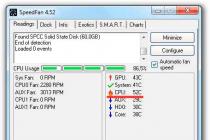Compare two devices with different operating systems just not correct. iPhones are bought for working with iOS, for services, in the end, for being just an iPhone.
An ordinary buyer usually does not care how many gigabytes of RAM are installed in it and what frequency its processor has - it works and pleases the eye, well, okay.
Android users choose their smartphones based on device performance, power and battery life, and for many, the version of the OS itself and the megapixels of the camera are just as important.
Despite the different operating systems, we will conduct a comparative iphone review 5s and samsung galaxy s5 let's try to find out which is better.
The approaches to devices are different, they are used for completely different purposes and before deciding on the choice, you need to understand what this smartphone is for, and only then compare the characteristics.
And here is a comparison of the characteristics:
Smartphone screens
The display size of the Samsung device is a whole inch larger - 5.1 versus 4 for the iPhone, and the resolution is 1920 by 1080 versus 1136 by 640, respectively. The Galaxy S5 has a pixel density of 432 versus 326 for Apple's device. Considering the size of the displays, the clarity of the picture is about the same, so it cannot be said that Apple's display is worse in terms of the announced parameters.
Processors
The iPhone has its own Apple A7 processor with two cores and a frequency of 1.3 GHz. Have Samsung Galaxy work is provided by the processor Qualcomm Snapdragon 801, with 4 cores and a frequency of 2.5 GHz.
You will be interested in
OS
As stated above, this is the main and most defining difference between these smartphones.
If a person wants iOS for himself, then whether an Android device is at least ten times more productive in terms of parameters, this will still not change his decision.
So if you already have iOS devices or plan to purchase them or want to combine and sync your devices into one ecosystem, then your choice is the iPhone.

Will you choose the iPhone 5s?
In all other cases - Android. because sharing devices on different OS will only bring unnecessary problems with synchronization, compatibility of services and payment for all kinds of subscriptions, which are different everywhere. And for applications from the store, which each OS has its own, you will have to pay separately.
RAM of flagships
Samsung has completed its flagship RAM in 2 gigabytes. For Android devices, this is a very important indicator, so the quantity here fully justifies itself. In the iPhone 5s, this figure is limited to one gigabyte and this is more than enough for the system to work.
Physical memory
Both smartphones are available in versions of 16 and 32 gigabytes, with the only difference that the iPhone lacks the ability to expand the amount of memory using an sd card, and the Samsung Galaxy s5 supports those up to 64GB.
Smartphone Cameras
Samsung's sensor size is 16 megapixels for the main camera, which is also equipped with flash and autofocus, and 2 megapixels is allocated for the front camera. The iPhone has an 8 megapixel sensor and is also equipped with flash and autofocus, as well as face detection and image stabilization.
Compare batteries
The battery capacity of both smartphones will be enough for active use during the day, and will have to be charged at night. In numbers, the iPhone is powered by a 1560mAh battery, while Samsung is powered by a 2,800mAh battery.
Make and model
Information about the brand, model and alternative names of a specific device, if any.
Dimensions (edit): 58.6 x 123.8 x 7.6 mm | Dimensions (edit): 69.7 x 139.3 x 6.7 mm |
|
| Alternative names | A1428 A1429 A1442 | SM-A500F A500F |
Design
Information about the dimensions and weight of the device, presented in different units of measurement. Used materials, offered colors, certificates.
SIM card
The SIM card is used in mobile devices to store data that certifies the authenticity of mobile service subscribers.
Mobile networks
A mobile network is a radio system that allows multiple mobile devices to communicate with each other.
| GSM | GSM 850 MHz GSM 900 MHz GSM 1800 MHz GSM 1900 MHz | GSM 850 MHz GSM 900 MHz GSM 1800 MHz GSM 1900 MHz |
| CDMA | CDMA 800 MHz CDMA 1700/2100 MHz CDMA 1900 MHz | - |
| CDMA2000 | 1xEV-DO Rev. A | - |
| UMTS | UMTS 850 MHz UMTS 900 MHz UMTS 1700/2100 MHz UMTS 1900 MHz UMTS 2100 MHz | UMTS 850 MHz UMTS 900 MHz UMTS 1900 MHz UMTS 2100 MHz |
| LTE | LTE 700 MHz Class 17 LTE 850 MHz LTE 1700/2100 MHz LTE 1800 MHz LTE 1900 MHz LTE 2100 MHz | LTE 800 MHz LTE 850 MHz LTE 900 MHz LTE 1700/2100 MHz LTE 1800 MHz LTE 1900 MHz LTE 2100 MHz LTE 2600 MHz LTE-TDD 2500 MHz (B41) |
Mobile technology and data rates
Communication between devices in mobile networks is carried out using technologies that provide different data rates.
Operating system
An operating system is the system software that controls and coordinates the operation of hardware components in a device.
SoC (System on a Chip)
A system on a chip (SoC) integrates all the major hardware components of a mobile device into a single chip.
| SoC (System on a Chip) | Apple A6 APL0589 | Qualcomm Snapdragon 410 MSM8916 |
| Technological process | 28 nm | 28 nm |
| Processor (CPU) | ARM Apple Cortex-A7 | ARM Cortex-A53 |
| Processor size | 32 bit | 64 bit |
| Instruction set architecture | ARMv7 | ARMv8 |
| Level 0 cache (L0) | - | 4KB + 4KB |
| Level 1 cache (L1) | 32 kB + 32 kB | 16 kB + 16 kB |
| L2 cache | 1024 kB 1 MB | 2048 kB 2 MB |
| Number of processor cores | 2 | 4 |
| CPU clock speed | 1300 MHz | 1200 MHz |
| Graphics processing unit (GPU) | PowerVR SGX543 MP3 | Qualcomm Adreno 306 |
| Number of GPU cores | 3 | - |
| GPU clock speed | - | 400 MHz |
| The amount of random access memory (RAM) | 1 GB | 2 GB |
| Memory type (RAM) | LPDDR2 | LPDDR3 |
| Number of RAM channels | Two-channel | Single channel |
| RAM frequency | 533 MHz | 533 MHz |
Built-in memory
Each mobile device has built-in (non-removable) fixed memory.
Screen
The screen of a mobile device is characterized by its technology, resolution, pixel density, diagonal length, color depth, etc.
| Type / technology | IPS | Super AMOLED |
| Diagonal | 4 in 101.6 mm 10.16 cm | 5 in 127 mm 12.7 cm |
| Width | 1.96 in 49.87 mm 4.99 cm | 2.45 in 62.26 mm 6.23 cm |
| Height | 3.48 in 88.52 mm 8.85 cm | 4.36 in 110.69 mm 11.07 cm |
| Aspect ratio | 1.775:1 | 1.778:1 16:9 |
| Permission | 640 x 1136 pixels | 720 x 1280 pixels |
| Pixel density | 326 ppi 128 ppcm | 294 ppi 115 ppcm |
| Color depth | 24 bit 16777216 flowers | 24 bit 16777216 flowers |
| Screen footprint | 61.05 % | 71.21 % |
| Other characteristics | Capacitive Multitouch Scratch resistant | Capacitive Multitouch |
| Corning Gorilla Glass LED-backlit Oleophobic (lipophobic) coating 800: 1 contrast ratio 500 cd / m² | - |
Sensors
Different sensors perform different quantitative measurements and convert physical metrics into signals that can be recognized by the mobile device.
Main camera
The main camera of a mobile device is usually located on the back of the body and is used for photo and video shooting.
| Sensor model | Sony IMX145 Exmor RS | Sony IMX135 Exmor RS |
| Sensor type | CMOS | CMOS |
| Sensor size | 4.54 x 3.42 mm 0.22 in | 4.69 x 3.52 mm 0.23 in |
| Pixel size | 1.382 μm 0.001382 mm | 1.136 μm 0.001136 mm |
| Crop factor | 7.61 | 7.38 |
| ISO (light sensitivity) | 50 - 3200 | 100 - 800 |
| Diaphragm | f / 2.4 | f / 2.0 |
| Focal length | 4.1 mm 31.21 mm * (35 mm / full frame) | - |
| Flash type | LED | LED |
| Image Resolution | 3284 x 2448 pixels 8.04 megapixels | 4128 x 3096 pixels 12.78 megapixels |
| Video Resolution | 1920 x 1080 pixels 2.07 megapixels | 1920 x 1080 pixels 2.07 megapixels |
| Video - frame rate / frames per second. | 30 frames / sec | 30 frames / sec |
| Specifications | Autofocus Digital zoom Digital image stabilization Geographic tags Panoramic shooting HDR shooting Touch focus Face recognition | Autofocus Digital zoom Geographic tags Panoramic shooting HDR shooting Touch focus Face recognition Adjusting the white balance ISO setting Exposure compensation Scene selection mode |
Additional camera
Additional cameras are usually mounted above the screen of the device and are used mainly for video calls, gesture recognition, etc.
Audio
Information about the type of speakers and audio technology supported by the device.
Radio
The radio of the mobile device is a built-in FM receiver.
Wi-Fi
Wi-Fi is a technology that enables wireless communication for transferring data over short distances between various devices.
USB
USB (Universal Serial Bus) is an industry standard that allows different electronic devices to exchange data.
Headphone jack
This is an audio connector, which is also called an audio connector. The most widely used standard in mobile devices is the 3.5mm headphone jack.
Connecting devices
Information about other important connection technologies supported by the device.
Browser
A web browser is a software application for accessing and viewing information on the Internet.
Video file formats / codecs
Mobile devices support different video file formats and codecs, which respectively store and encode / decode digital video data.
Battery
Mobile device batteries differ in their capacity and technology. They provide the electrical charge required for their function.
| Capacity | 1440 mAh | 2300 mAh |
| Type of | Li-polymer | Li-Ion (Lithium-ion) |
| Talk time 2G | 8 h 480 minutes 0.3 days | 15 h 900 minutes 0.6 days |
| Standby time 2G | 225 h 13500 minutes 9.4 days | - |
| Talk time 3G | 8 h 480 minutes 0.3 days | 15 h 900 minutes 0.6 days |
| 3G standby time | 225 h 13500 minutes 9.4 days | - |
| Adapter output power | - | 5V / 1.5A |
| Specifications | Non-removable | Non-removable |
A new generation of devices Galaxy line A has already been announced and we can take a closer look at the Galaxy A7 (2016) and Galaxy A5 (2016). We're especially curious about how good their cameras are and, to get a better idea, we'll compare them to each other and Apple's current flagship iPhone 6S.
Galaxy smartphones The A7 (2016) and Galaxy A5 (2016) are extremely similar: both have the same design, but different screen sizes.
In terms of camera specifications, both are also identical: the same 13-megapixel main camera with f / 1.9 aperture and optical stabilization, as well as a 5MP front camera.
We're curious about how high-quality the images are compared to the iPhone 6S, which has one of the best sensors on the market.
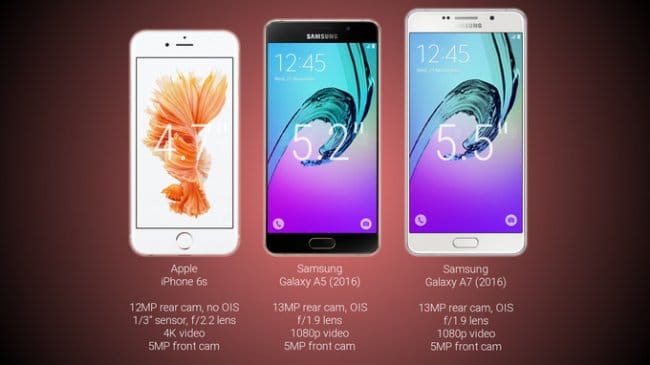
General impressions
After several days of testing Galaxy devices under various conditions, we came to this conclusion: new Galaxy The A7 and Galaxy A5 have identical cameras. We haven't seen any significant differences in photo quality throughout the entire time, so we believe both phones have the same cameras.They shoot quickly and efficiently. Shortcut “ Quick start”(Double-tapping the Home button) opens the camera app almost perfectly. No accidental startup problem was observed. The app menu is the same as the Galaxy S6 and Galaxy Note 5: Convenient separate buttons for taking photos and recording videos, as well as buttons for switching between the front and rear cameras are located at the bottom for easy access.
Image quality comparison


The Samsung Galaxy A7 / A5 don't actually take bad pictures, but they do look a little blurry. Apple iPhone The 6S, by comparison, captures much more dynamic footage that is more enjoyable to look at. He manages to shoot richer and sharper pictures. You can verify this by looking at the images below.
The second shot, taken with a Samsung smartphone, looks more interesting. It is characterized by natural color reproduction. The iPhone, in turn, shows a more impressive picture: the colors are deep and, perhaps, even too much, although the picture seems more vibrant. You can see the difference if you compare the sky in both photos.



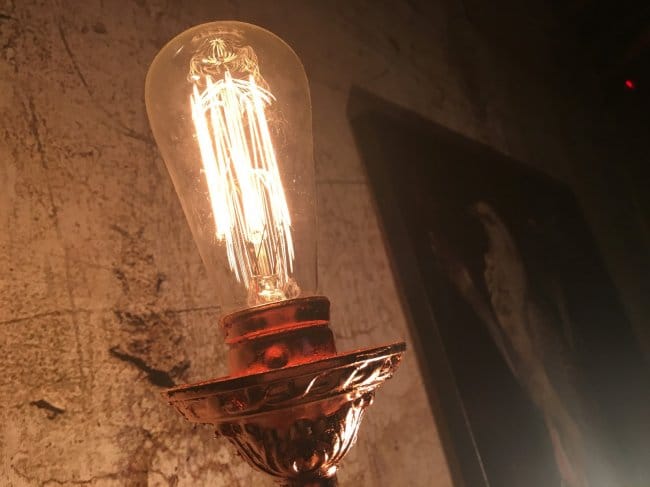
The heroes of our comparison encountered another difficult scene near the bar counter. And here Galaxy devices lost to their opponent. While both phones are equipped with optical image stabilization, their cameras were unable to get a clear picture. The iPhone only has digital stabilization, and it showed itself where better Galaxy A7 2016 and Galaxy A5 2016. The American gadget is capable of shooting at ISO 640 with an impressive shutter speed of 1 / 17th of a second, while the South Korean gadget is capable of shooting at ISO 1250 and a shutter speed of 1 / 8th of a second.


When it comes to selfies, both Galaxy smartphones take good shots with wide viewing angles. This way you will be able to take a selfie with all your friends without any problem. The iPhone is completely different: it is rather difficult to take pictures with several people at once, they just do not fit. The color difference is also quite noticeable. The shots taken with the Galaxy A7 / A5 look more authentic, while the iPhone 6S has clearly oversaturated colors.


Video quality comparison
Samsung has equipped the Galaxy A7 (2016) and Galaxy A5 (2016) with cameras that can shoot 1080p at 30 frames per second. Apple, in turn, equipped its flagship with a module that provides the user with 4K video recording.The difference is big: the smartphone of the American manufacturer shoots videos with much better clarity than the South Korean one, and this is something that you will immediately notice when you view the video on a 1080p screen.
According to our initial impressions, the iPhone 6S has a wider picture dynamics and is able to handle tasks more efficiently in difficult conditions. When the sun shines right on the lens iPhone camera does not distort the picture and it manages to provide a balanced frame, although the Galaxy is also not bad, but not perfect.
Outcomes
The cameras of the Samsung Galaxy A7 (2016) and Galaxy A5 (2016), as we said, are identical. Both are doing their job well, but not excellent either. Of course, it lacks slow motion and 4K video recording support, although 1080p will be enough for many.Leave your feedback in the comments. How satisfied are you with the quality of the photos taken with the Galaxy A7 / A5 (2016)?
Now, after the official announcement, we know the whole truth about the Samsung Galaxy S5 - the new flagship of the Korean manufacturer. If so, then it's time to compare it with its main competitor - the iPhone 5S.
Why exactly the iPhone 5S, released last fall? Why not wait for the official information about the iPhone 6?
Because the iPhone 6 will not appear soon - more than six months later, and the Galaxy S5 will start selling on April 11. And it really has to compete with 5S. It is difficult to say what goals Samsung pursued (and whether it pursued it at all), taking its flagship outside the update cycle of its main competitor.
But now is not about that - let's compare. Of course, we have not yet held the Galaxy S5 in our hands, and are based only on information from the official announcement - but this is perhaps quite enough.
Body, dimensions and design
In this respect, the Samsung Galaxy S5 differs little from its predecessor. Most notably, the Galaxy S5 is an IP67 dust and water resistant smartphone. However, that doesn't mean it's waterproof and you definitely can't use it as an underwater camera. However, rain or sand is not too scary for him.
The Samsung Galaxy S5 weighs 145 grams and is 8.1mm thick - which means it is slightly heavier and thicker than the Galaxy S4 was (which weighed 130g and was 7.9mm thick). Galaxy smartphones will always be bigger and heavier than iPhones - after all, they have a bigger screen. Galaxy - large, eye-catching phones with a screen big size, but may not be very comfortable to use and wear. A matter of taste.
iPhone 5s has the same size, shape, design and weight as iPhone 5. It is a slim, ergonomic smartphone: one that you can easily operate with one hand. The iPhone 5S weighs 112g and is 7.6mm thick.
A few words should be said about the design and build quality of both devices. We prefer the aluminum bumper of the iPhone over the plastic and streamlined design of the Galaxy S5. But if you want to keep your Apple smartphone, you shouldn't neglect the protective case. We expect the Galaxy S5 to be more durable than the iPhone 5s thanks to its water and dust resistance.
As expected, Samsung has released several color-coded variants of the Galaxy S5, but they are all made of plastic - although there were rumors that there would be a metal version similar to the iPhone. The smartphone is available in the following colors: blue, black, white and copper gold. The back covers are perforated.
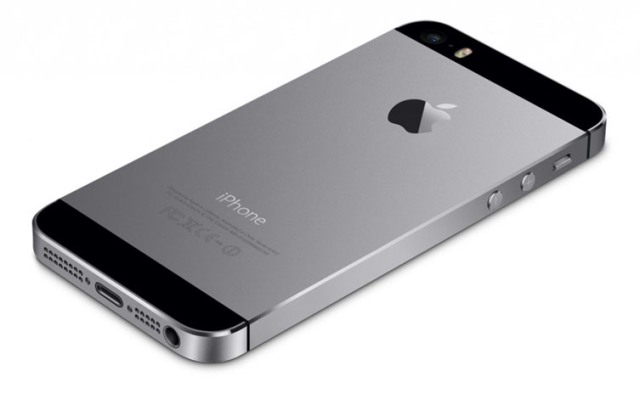
Fingerprint scanner and other sensors
Like the iPhone 5S, the Galaxy S5 now has a fingerprint scanner. Samsung says it will provide a secure biometric screen lock function and easy payments. Also, using this scanner, you can restrict access to files on the device
The Galaxy S5 also has a window below rear camera... This is not a flash or a flashlight. It's actually a heart rate sensor that measures your heart rate when you place your finger on it. Apple does not have anything like this yet, but is there a lot of practical benefits from such a function?
WiFi and 4G
Galaxy S5 supports work in LTE networks and Wi-Fi MIMO (802.11ac), which Samsung says makes it unique. The Galaxy S5 also features a download accelerator and technology that boosts data transfer speeds by simultaneously connecting via Wi-Fi and LTE.
The iPhone 5s offers 802.11n Wi-Fi connectivity, and full 4G support. Including, recently, in Russia.
It looks like the Galaxy beats formally, although it's clear that 802.11ac is only useful when you have the right router, and 4G networks aren't available everywhere.
Display
Rumors before the release of the Galaxy S5 were about a 5.2-inch screen with a whopping 2560 × 1440 resolution. However, in reality, the display is 5.1 inches and has a resolution of 1920 x 1080. This means that Samsung flagship has even a slightly lower pixel density (430 ppi), compared to 441 ppi in the Samsung Galaxy S4.
iPhone 5s has a 4-inch display. You get a resolution of 640 x 1136 pixels, with a density of 326 ppi. This is more than a decent screen - but, nevertheless, compared to the large FullHD displays of competitors, it already seems outdated.
Not everyone appreciates full-blown color Galaxy phones... For example, the photos in them may look too oversaturated. And while a large, high-resolution display "on paper" is better than iPhone screen 5s, your eyes are unlikely to be able to tell the difference. And a bigger screen means bigger dimensions. There is something to think about.

Battery capacity
Samsung states that Galaxy battery The S5 provides 390 hours of standby time and 21 hours of talk time. IPhone Battery 5S has a talk time of up to 10 hours (on 3G networks), and up to 250 hours of standby time. Of course, the Galaxy S5 battery still needs to be tested.
The Samsung Galaxy S5 has a special Ultra Power Saving Mode that switches the display to monochrome and disables many features to reduce battery drain. Samsung says this mode provides an additional 24 hours of battery life.
Processor and performance
We know the Galaxy S5 is equipped with a 2.5GHz quad-core Qualcomm processor Snapdragon 805. Contrary to rumors, this is not an x64 processor.
We also counted on an impressive 3GB of RAM, but according to Samsung's spec, the RAM is 2GB.
The iPhone 5s has a 64-bit A7 processor clocked at 1.3GHz. It is a dual core processor paired with 1GB DDR3 RAM. The iPhone has never had a performance issue, but Apple claims this processor is twice as fast as the previous model, both in terms of CPU and graphics performance.
The flawless operation of 64-bit iOS 7 is definitely the main merit of this chip. You will not notice any freezes or lags when moving between desktops, or when exiting an application. Apps launch and web pages load faster than ever: iPhone 5s is a pleasure to use.
The A7 also has the M7 coprocessor, which takes over a number of background functions and seriously affects the performance of the gadget.
Benchmarks show just how fast the A7 processor makes the iPhone 5S. In SunSpider 1.0, the Apple smartphone completed the test in just 417ms. At the same time, the iPhone 5 (running on IOS 7) completed the task in 721 ms, and the Samsung Galaxy S4 in 922 ms.
A similar increase is observed in graphic tests... In Geekbench 3, the predecessor of the current flagship, the iPhone 5, earned 721 points. And the iPhone 5s is almost 1.5 times larger - 1,076! In GLBenchmark 2.7 (Egypt HD), the iPhone 5s achieved 53 fps, while the iPhone 5 only had 41 fps. However, the biggest difference in performance was achieved in the popular T-Rex HD benchmark, where the flagship showed 37 fps and its predecessor only 14 fps. More than a twofold advantage.
However, benchmarks are always rather arbitrary. Plus, we can't test the Galaxy S5 yet.
![]()
Built-in memory
iPhone 5s is available in 16GB, 32GB, and 64GB storage options, and does not have a memory card slot.
The Galaxy S5 offers 32GB and 64GB models, and with a microSD card, the owner can add up to 64GB. So Galaxy wins in this regard.
Software
The choice between Android and iOS is still the subject of fierce controversy.
iOS now comes with a very handy feature quick setup- called "Control Center". There are other important changes compared to older versions, for example - blocking access to the notification center.
Apple also has strong point as App Store, but iOS is clearly inferior to the competitor in customization options, which is one of the main advantages of Android.
Galaxy S5 works under Android 4.4 KitKat. It is Google's most sophisticated and easy-to-use mobile operating system, even equipped with the TouchWiz interface from Samsung. Surprisingly, this time around Samsung didn't overload the phone with too many of its proprietary features. Perhaps because of the agreement between Samsung and Google, but also likely because the Galaxy S4 has been criticized for duplicating features in apps and settings.
If you've used a Samsung smartphone before, then you know what to expect. This smartphone may not have the Apple polish, but it does provide you with the ability to purchase content from a variety of sources. However, Android may also be less secure than iOS.
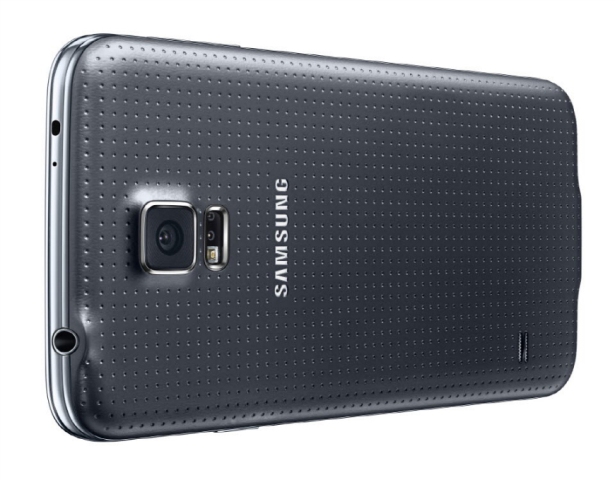
Cameras
Naturally, we haven't tested yet Galaxy camera S5, and we only have confirmation that the main camera has a resolution of 16MP, autofocus of 0.3 seconds (dubbed "fastest autofocus" by Samsung), and an LED flash.
Other innovations include advanced advanced dynamic range(HDR). This means you don't have to hold the camera still for long periods of time while it takes multiple shots and merges them into one.
There is also a focus mode selection that allows users to focus on a specific area of the subject while blurring the background to create an effect of depth.
The Galaxy S5 also offers an improved interface that makes it easy to capture, edit, and share.
Front-camera will have a resolution of 3.2 megapixels. You can shoot video in 1080p resolution at 60 frames per second.
The iPhone 5s also has two cameras: a front one for apps like FaceTime and Skype, and a main rear one called iSight. Below are their characteristics.
iSight has a modest 8 megapixel sensor with 1.5µ (UltraPixel technology for better low-light shots). The aperture size is ƒ / 2.2, and the True Tone flash has two LED elements, one of which is yellow. The front camera can take pictures with a resolution of 1.2 megapixels, and record videos in 720p HD.
Importantly, the iPhone 5s no longer uses wide mode in low light conditions (like the iPhone 5 did), so photos taken in the dark are much sharper.

Prices and availability
iPhone 5s is on sale right now at prices starting at 24,000 rubles if you buy the phone in the online store. The Galaxy S5 will go on sale on April 11, but pricing has yet to be announced. We expect that the Galaxy S5 in Russia will cost in the range of 28,000 to 35,000 rubles.
Our verdict
If you are an iPhone user and are completely happy with iOS 7, it is unlikely that any Galaxy functions The S5 will convince you to go to the Android camp.
Galaxy S5 will have a big and bright screen, good cameras, various connection options and a large amount of memory. But all of the above is also true for the iPhone 5S.
The days when Apple was way ahead of other smartphone makers are over, but the iPhone is still at the top.
Let's try to answer the prosaic question: what better iPhone or samsung?
Smartphone manufacturers like to call their creations digital-letter combinations. The combination of the serial number of the model and the letter S is especially popular.
Competitive manufacturers are also noted for this enthusiasm. smartphones Samsung and Apple .
The difference between the sizes of the fifth models is striking, especially when they are in the hand.
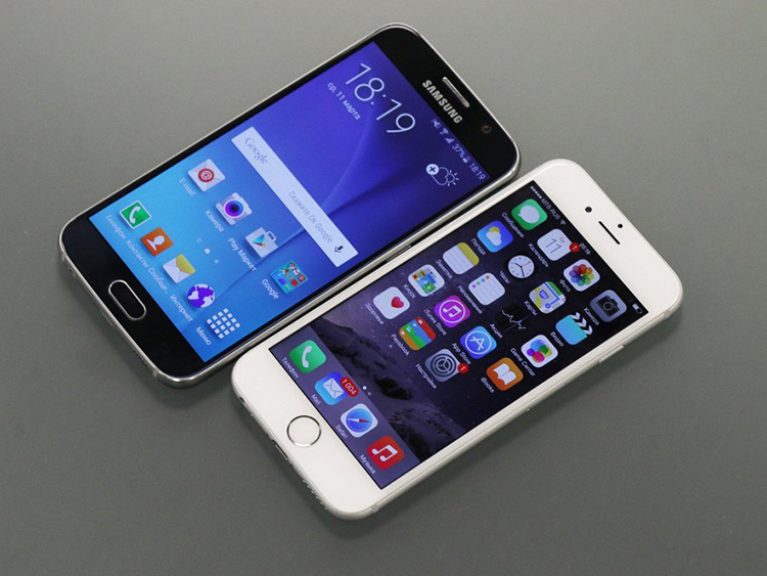
Despite the large dimensions of Korean phones, Californian ones are always somewhat slimmer. The iPhone 5s is almost 2mm thinner than the competitor, and the 6 is one millimeter thinner.

However, this circumstance is concealed by the rounded edges of Samsung. Because of this, they visually appear thinner.
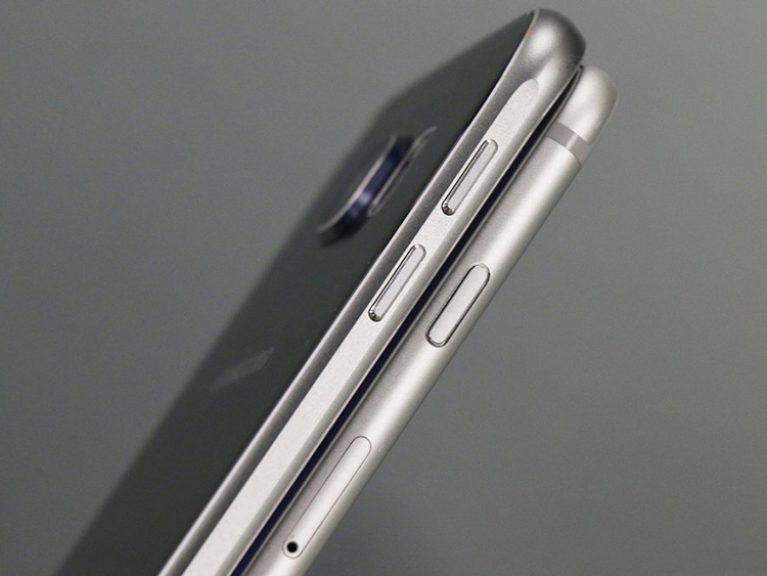
In terms of weight ratio, the difference between the fives is striking - 13 grams. The Apple Device is, of course, lighter. But for the sixth generation models, the difference in weight is 9 grams.
It is noteworthy that of all the phones described, only one (Samsung Galaxy S5) has a removable back cover.
The sixth model of the Korean Galaxy flagship has acquired a solid body.
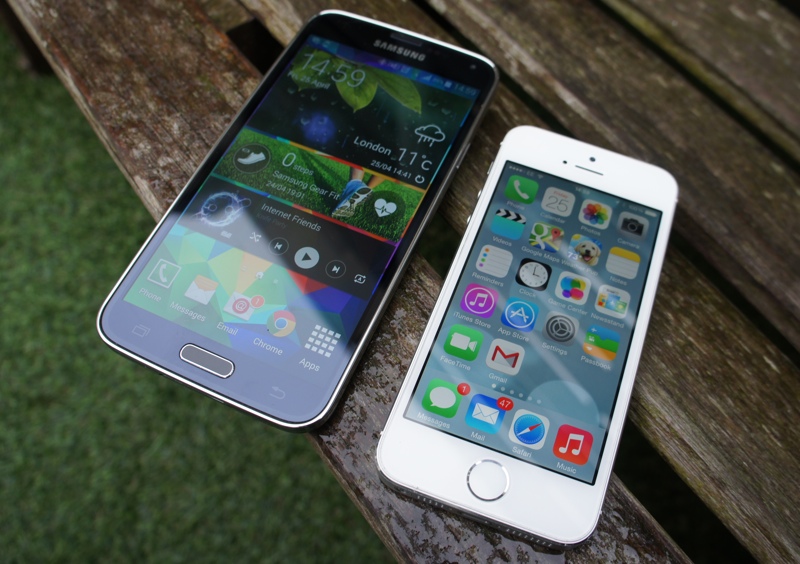
In the sixth Galaxy models the engineers decided to abandon not only the removable cover, but also the plastic. Now the device is protected from all sides by Gorilla Glass 4.

The "apples", as always, have aluminum.
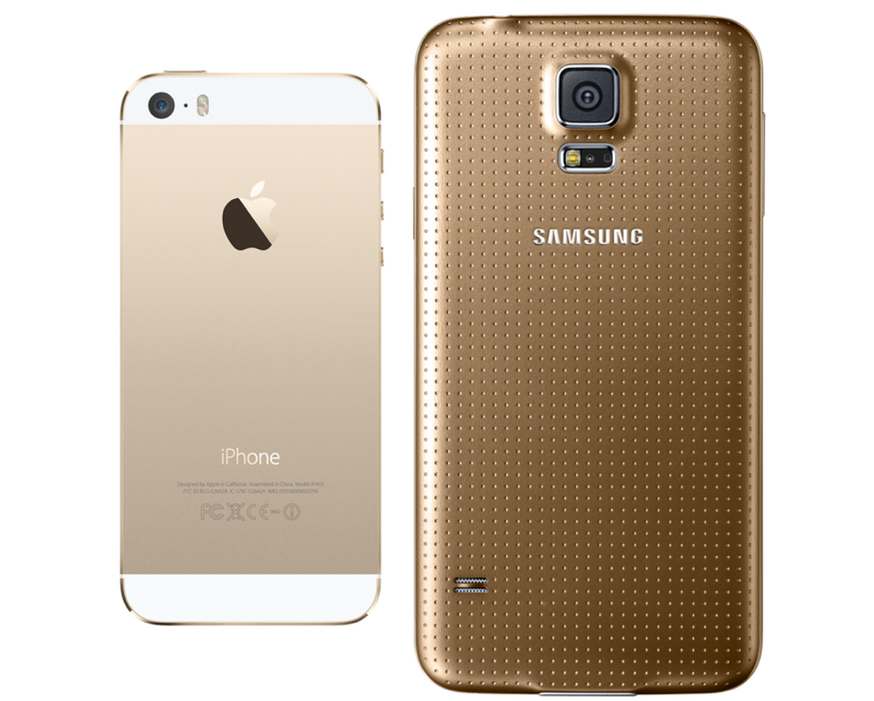
The assembly of all devices is solid, but the Galaxy S5 has also become dustproof.
For "apples" a high-quality assembly is a standard, but the S6 is the first monolithic device from a Korean company.
In terms of build quality and materials used, the sixth models are equal, and the fifth "Korean" is slightly inferior to the device from Apple of the same generation.

Note! The iPhone is more prone to slipping out of the palm of both the fifth and sixth. And if in the fifth it is compensated by compactness, then the sixth strives to "jump" out of hand. Samsung is fine with that.
Battle on displays
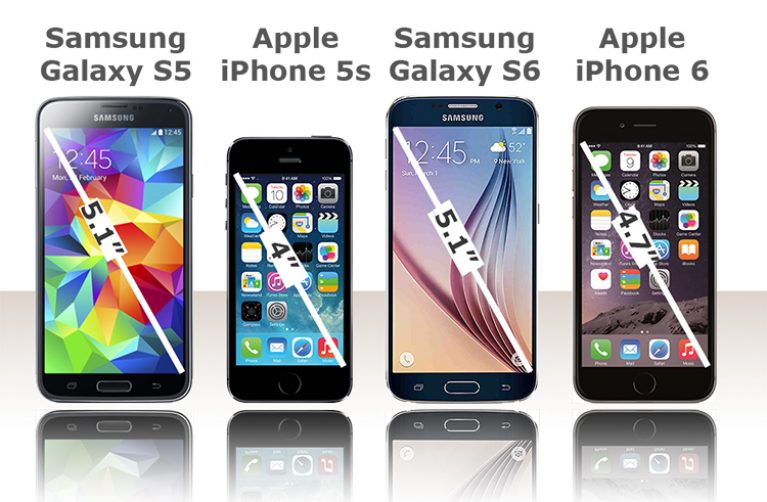
All phones have good screens (even the fifth models). There is nothing to compare specifically. The data on their parameters, summarized in a table, will be much clearer.
| ModelParameter | Galaxy S5 | iPhone 5s | Galaxy S6 | iPhone 6 |
| Technology | SuperAMOLED | IPS | Super AMOLED | IPS (Retina HD) |
| Diagonal | 5.1 inch | 4 inch | 5.1 inch | 4.7 inch |
| Permission | 1080 × 1920 | 1136 × 640 | 1440 × 2560 | 1334 × 750 |
| Ppi | 432 | 326 | 577 | 326 |
| Color rendering | 16 million | 16 million | 16 million | 16 million |
More detailed specifications useful only to enthusiastic people. In practice, we see fairly crisp screens (even at 326 ppi).
Some of the disadvantages of color reproduction include the fact that the spectrum “slides” into blue, and Samsung - into red, but this does not interfere with the transfer of a juicy picture.
Resolution and diagonal are also controversial. The sixth generation of both devices received a record large screens.
This is a great solution for working with multimedia, but at the same time it mercilessly eats up battery charge .
Filling smartphones
It makes no sense to compare the fifth and sixth models with each other, because the continuous development of technologies does not give everyone the opportunity to keep up with them, and what was a breakthrough a year and a half ago is now irrelevant.
Processors and performance
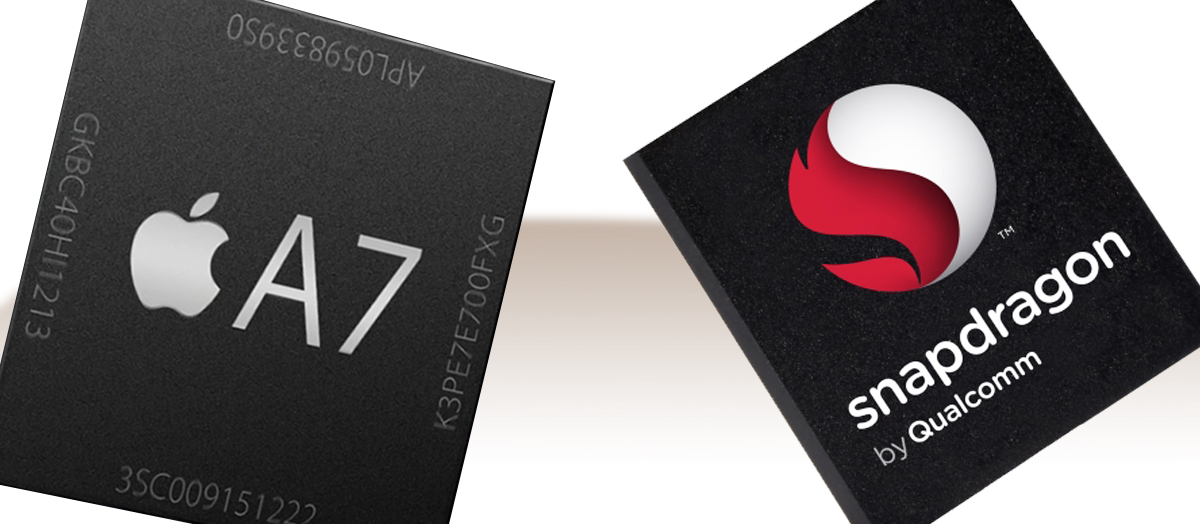
The fifth models are equipped with A7 (iPhone) and Snapdragon 801 (Galaxy S5) processors, respectively. The first is dual-core at 1.35 GHz, the second is for four cores with a clock frequency of 2.5 GHz.
Note! With such a spread clock frequency performance is more influenced by the OS. So, iPhone faster the competitor opens native applications, while Samsung opens third-party applications.
Apple's sixth models have consistently followed tradition with their own 1.4GHz dual-core A8 processor.
The Korean company also decided to use its own processor and installed in the S6 Samsung Exynos 7420 is an eight-core CPU.
The eight cores are actually split into two quad-core processors at 1.5 and 2.1 GHz.
A less powerful chip acts as an auxiliary one and turns on only at high loads.
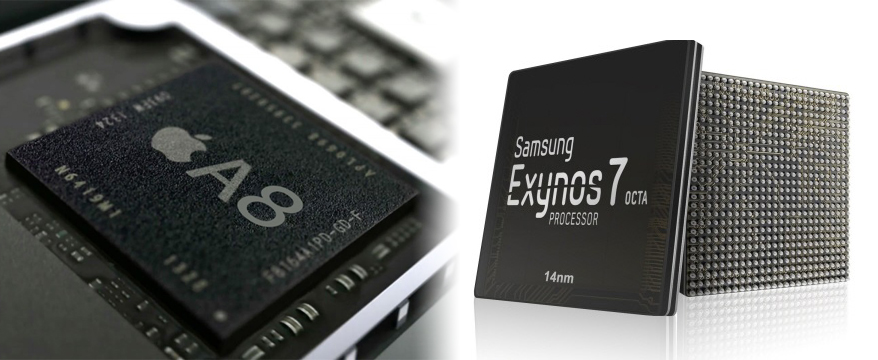
Memory: operational and stationary
Which smartphone can store more information? Samsung is doing better with RAM: S5 - 2 GB, S6 - 3 GB. Both "apples" are supplied with 1 GB.
Moreover, their performance does not suffer, because of the excellent optimization. Only the S5 has an SD card slot (up to 128GB).
The rest of the models are offered with built-in data storage (S6 - 32/64/128 GB, 5s - 16/32/64, 6 - 16/64/128).
At the same time, the actually available space for storing personal data will be slightly less, since this parameter does not take into account the OS.
Autonomy and battery
The battery capacity of both Galaxy (2,550mAh for the S6 and 2,800mAh for the S5) is almost twice that of the iPhone (1,810mAh for the 6 and 1560 for the 5s). Autonomous work all devices have about the same.
Why it happens?
Because "Koreans" use more power-hungry processors.
Each device is capable of being in standby mode for about 260 hours, providing 20 hours of talk time and about 50 hours of playing music.
Fingerprints
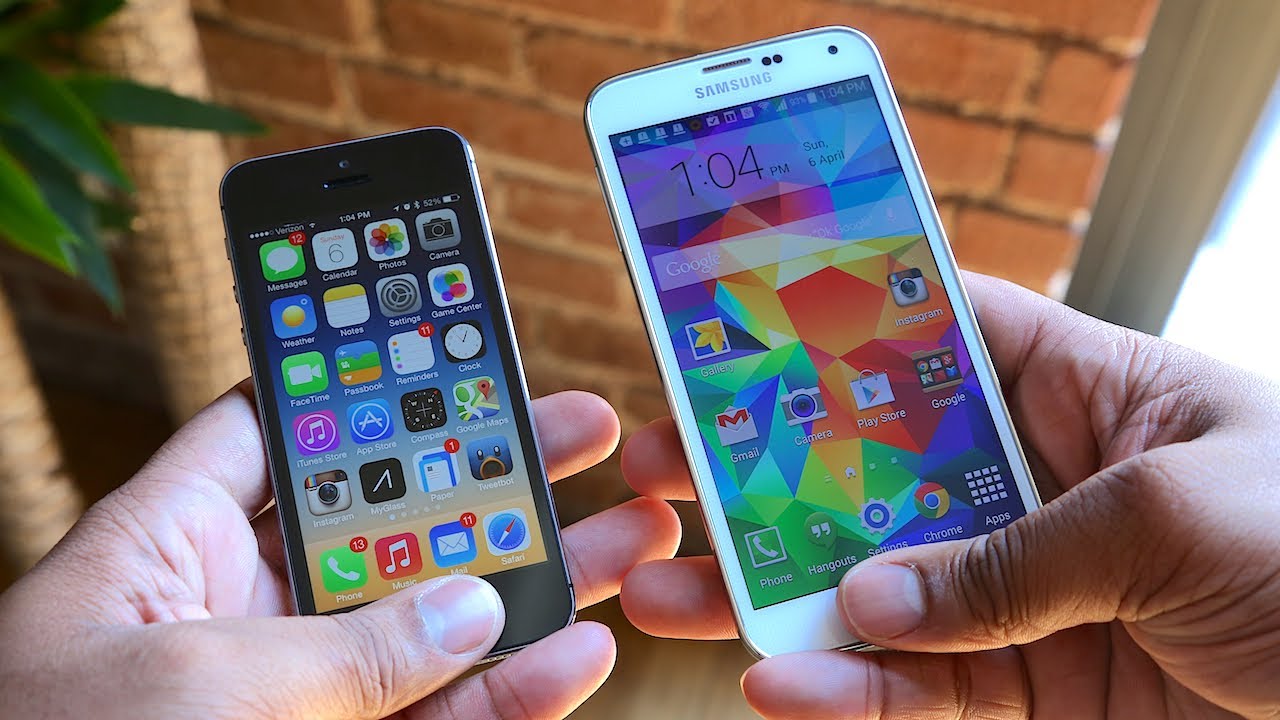
All the presented devices are equipped with a fingerprint sensor.
And if it works fine for the older generation Samsung and both iPhones, then the S5 is equipped with some kind of frank misunderstanding.
To, you need to slide your finger across the screen.
It is impossible to do this with one hand.







